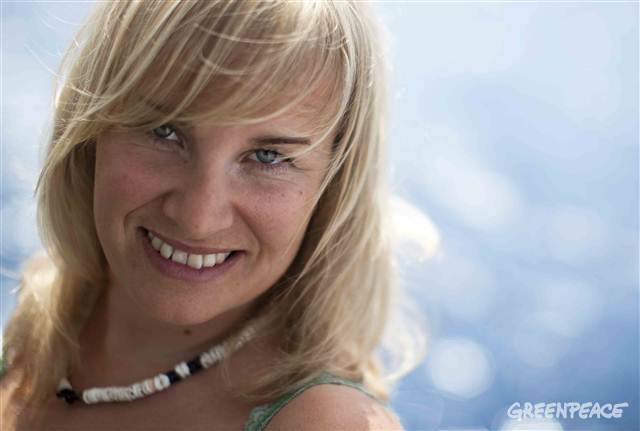
Blogpost by Sari Tolvanen – December 20, 2011 at 13:31
My job as a Greenpeace oceans campaigner has sent me to lots of places in the past ten years- on land and at sea. Last month, I was in Manila, Philippines to meet with the president of Frabelle fishing corporation, one of the largest Filipino fishing companies. I was already in Asia and a few days before I was in Seoul to meet with the representatives of the tuna fishing association there along with our Korean office staff. As Greenpeace continues to expand its oceans work in Asia, our staff in the region are working around the clock to change the minds of the men and women who profit from the continued plunder of our already vulnerable oceans. They must be held accountable for the failing management of tuna – key to the Pacific region’s food security and economic prosperity.
My visit to Frabelle headquarters was different in that I wasn’t there to negotiate a better policy for the company or persuade them to act to protect fish for the future. I was there to document a company that had already switched to more responsible fishing.
Just a day before, Greenpeace’s largest ship Esperanza, as part of the three-month Defending our Pacific tour had joined a Frabelle purse seine fishing vessel, the Purple Lilac 888, in the waters of Papua New Guinea to document the more sustainable ways that one can catch tuna. These waters near PNG are some of the richest tuna fishing grounds in the world, very biodiversity-rich, and are part of an area called the coral triangle. When we arrived, Purple Lilac had made a big haul of almost 90 tonnes of skipjack tuna: not something you would expect a Greenpeace campaigner to be exactly happy about, but as a matter of fact this event represented a culmination of years of campaigning at sea, in the corridors of political meetings and in the global tuna market place. See for yourself.
The Frabelle vessel was fishing tuna without the use fish aggregation devices or FADs. These drifting devices became popular in Pacific fisheries in the early 2000s and now most purse seine fishing fleets are depending on them for find and catch tuna. The downside of finding fish easily is that many other marine life like to hang around these FADs too- and end up as by-catch including sharks and juvenile tuna. This is especially problematic for juvenile tunas of the more vulnerable tuna species like bigeye and yellowfin that get caught as fishing boats catch skipjack tuna for canning.
The fishing industry in the Pacific has begun to change, though- as a result of Greenpeace campaigns against the use of FADs in these fisheries and market pressure on companies toswitch away from selling unsustainably-caught tuna. Tuna companies are increasingly switching to pole and line caught tuna and to FAD free purse seine fishing. This industry transformationhas taken a lot of steer from the Pacific Island Countries themselves that depend on these fisheries for food and jobs, and whose futures are on the line should tuna disappear. This company is taking steps toward improved tuna fishing, and we hope that it is not an isolated case: more action is needed to ensure the fishing industry continues to improve, reduce the catch of vulnerable species and cut fishing effort to match what is sustainable and economically viable in the long-term. Only by ensuring tuna for the future can the industry itself also have a future. It is indeed a happy day for a campaigner like me to see industry take sustainability seriously and began implement it on the water. By asking your tuna companies to switch to sustainable tuna we can support progress and ensure the world’s largest tuna fishery in the Pacific is able to feed future generations.
Sari Tolvanen is an oceans campaigner based in Greenpeace International’s Amsterdam office.


